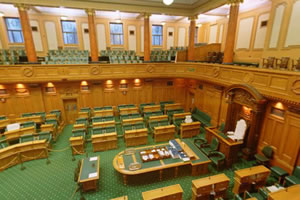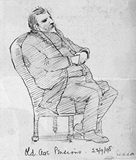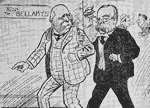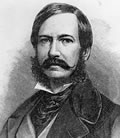House of Representatives: The Opposition
Debating chamber, view from galleries. View as panorama.
Testing the government
The Opposition uses a variety of tactics to hold the government to account. In the past, slowing down or obstructing business was common practice. Sometimes the Opposition simply walked out of the chamber en masse so there would be no quorum and a vote could not be taken.
Before the 1930s, the Opposition could bring the House to a standstill just by talking on and on. This was known as 'stonewalling' or 'filibustering' — using the standing orders or speaking so long in a debate that business ground to a halt. Stonewallers had to be organised: they would speak in shifts to keep a debate going, sometimes for several days. Some speeches were downright silly — MPs would talk about their favourite hobbies, or name all the people in their electorate. One MP spoke for over 24 hours during a stonewall in 1876 that went on for four days. MPs would bring blankets and pillows into the House so that they could snooze in comfort. Stonewalling did not disappear until 1936 when the Labour government introduced the 'closure' — moving that a debate terminate.
Bringing down the House
Some of the most dramatic votes in the history of the House have been 'no-confidence' motions. These were moved by the Opposition to test the government's majority, or the confidence of the House. Governments could be toppled by these divisions.
One of the most famous no-confidence votes occurred in 1912 when a division called by the Reform Party led to the defeat of the Liberals. One Liberal MP who voted against the government ― John Millar ― crawled out of his sick bed and entered the chamber wearing his dressing gown and pyjamas. Members of his own party shouted 'traitor' at him as he voted against them. The Opposition formed into a 'crocodile' behind Reform leader William Massey, and marched jubilantly into Bellamy's where the victory celebrations continued into the following morning.
Down the Hatch
In 1872 William Fox's government fell after its plan to secure the vote of MP Edward Jerningham Wakefield failed dismally. Wakefield was a notorious drunkard, and it was thought that by locking him in a room until the division was ready to be taken he would stay sober and vote with the government. When the Opposition heard of this, one of its members lowered an opened bottle of whiskey down the chimney to Wakefield. The division bells rang and a government MP rushed to get Wakefield, only to find that he had drunk himself silly. Plan B failed, too. The government member plied Wakefield with more alcohol, but to no avail: he voted to throw out the government.
Asking questions
Question time is a chance for MPs to ask questions of ministers, although they may not always get the answers they want. Written notice would be given of questions to be answered. Government MPs would normally ask straightforward questions, but those in Opposition could ask curly questions that put the government on the spot.
Once parties formed from the 1890s onwards, question time became very popular with the public who went to Parliament to see MPs battle it out in words on the floor of the chamber. Two hours was put aside for questions on Wednesdays, and then in 1962, 30 minutes of oral ― as opposed to written ― questions began each sitting, with supplementary questions being asked at the discretion of the Speaker. Question time kept getting longer: 40 minutes in 1974, 45 in 1985, and then about an hour in 1996 when a greater number of questions requiring an immediate answer could be asked.
And the winner is…
The press gallery ran a 'King of the Quiz' competition to see which MP asked the most questions in a year. In the 1960s West Coast MP Paddy Blanchfield frequently came out on top, while Ethel McMillan was dubbed the 'Queen of Quiz'.
Next: Parliament: The Speaker >



